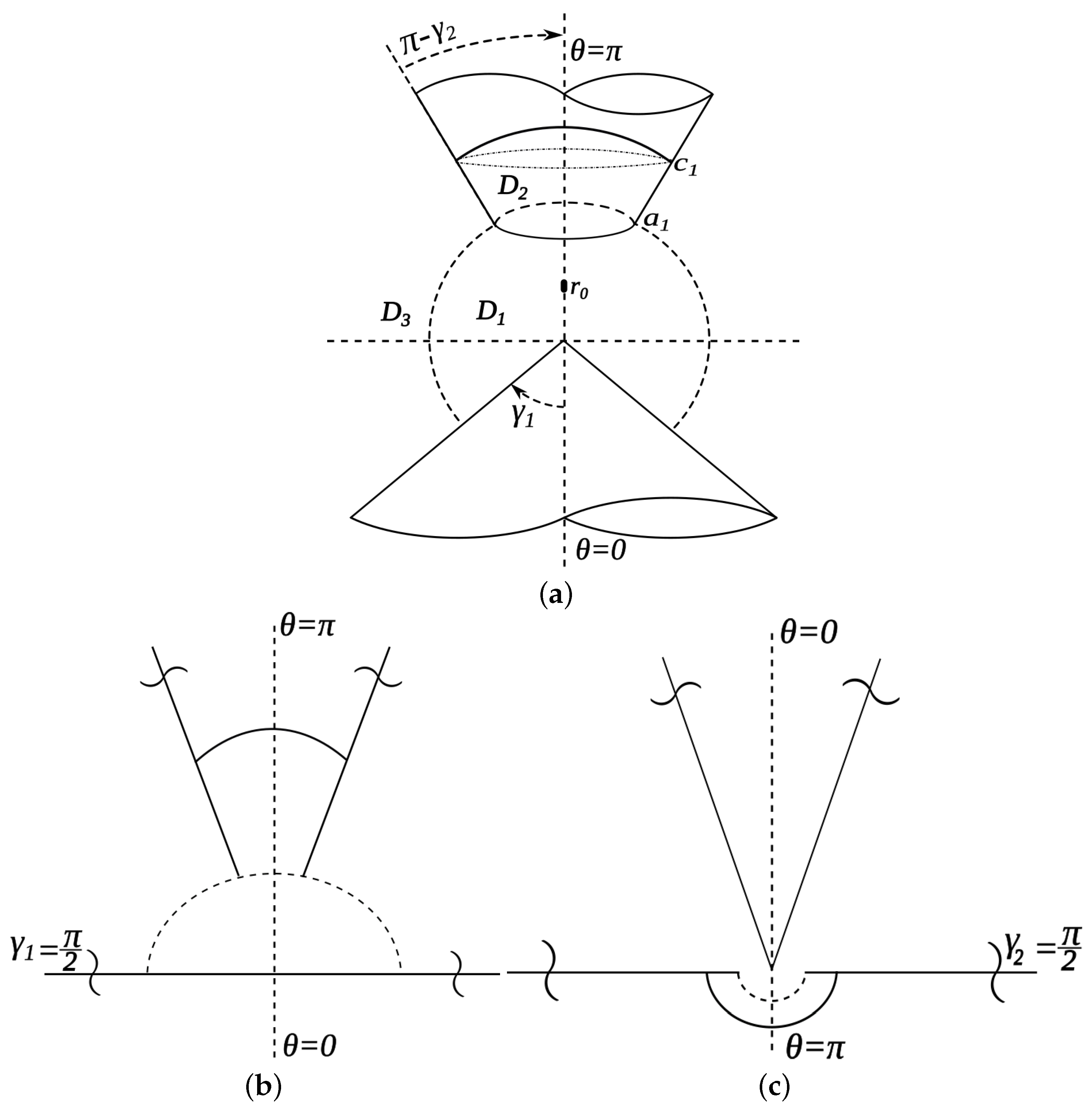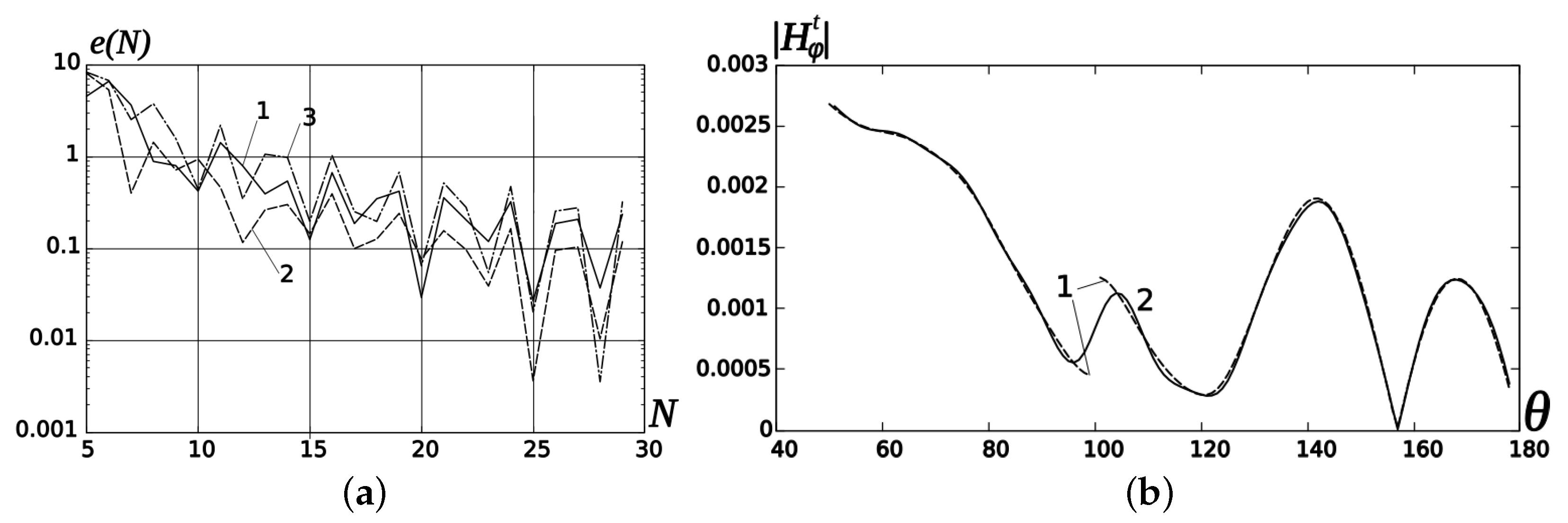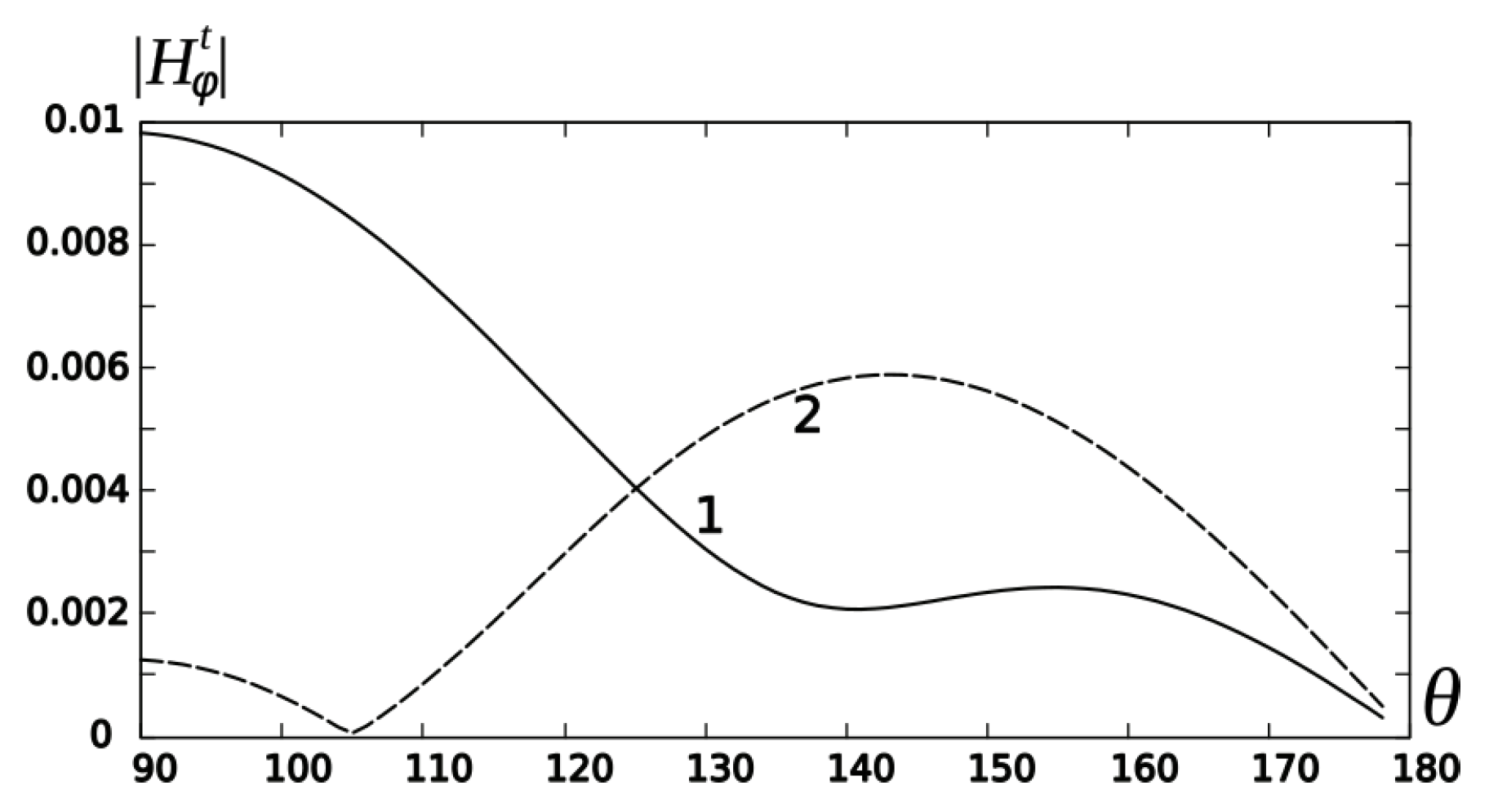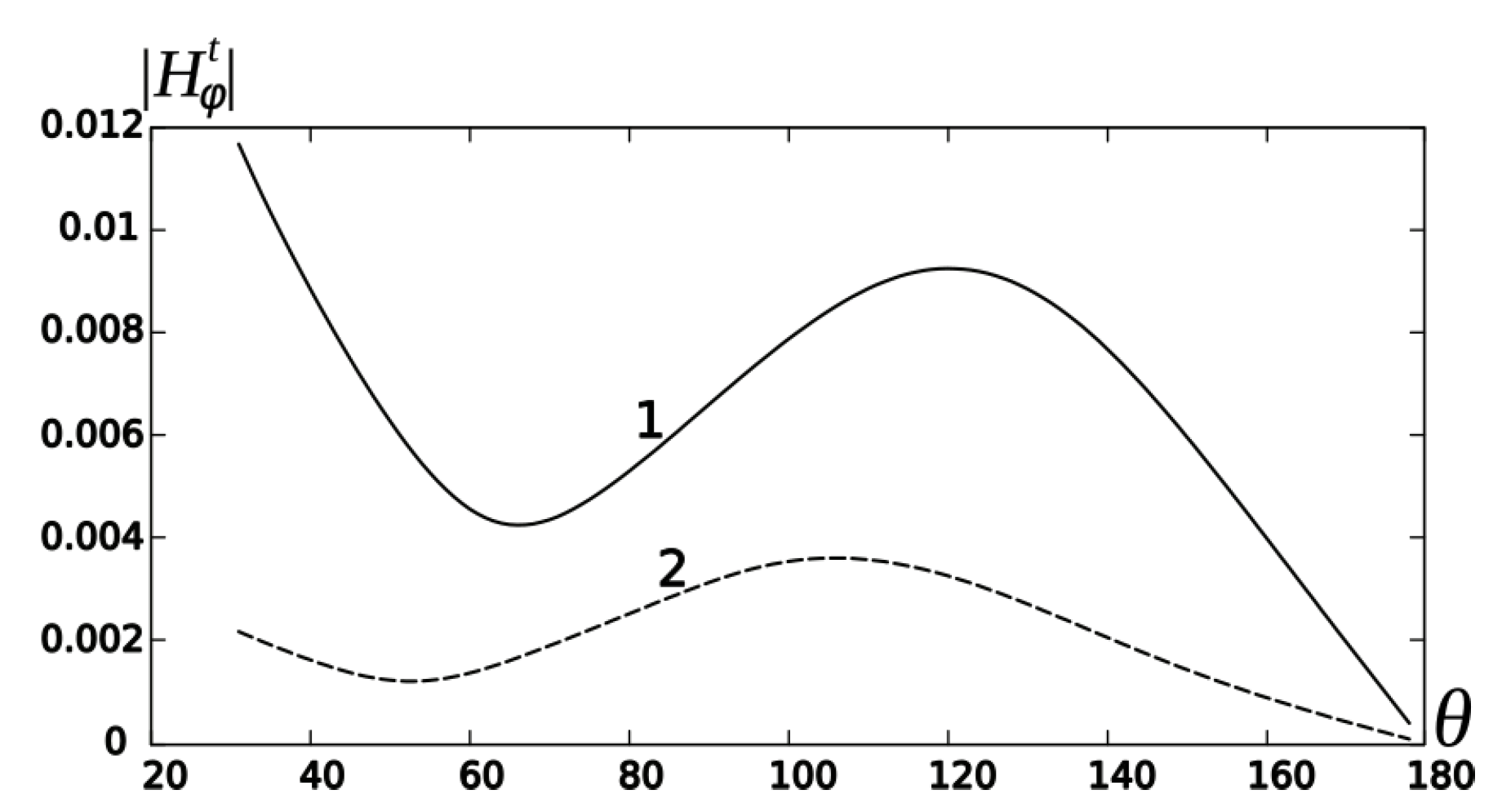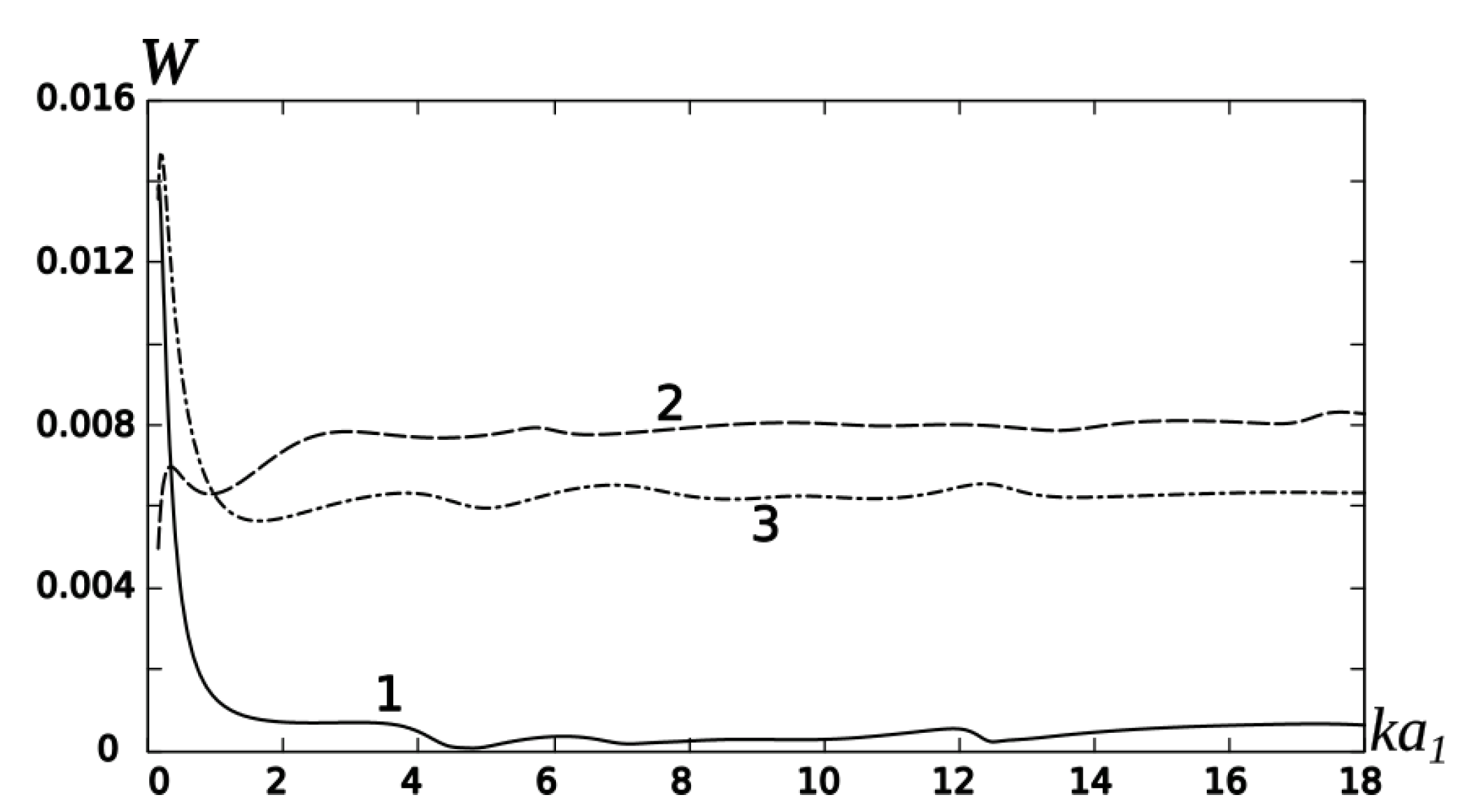1. Introduction
The progress of wave diffraction simulation for determining the coupling between the radiating elements in radiophysics, optics, and acoustics often relies on the availability of solutions to canonical problems. This paper considers the bicone conjoined with an open-ended conical cavity formed by a perfectly conducting semi-infinite cone and a truncated one with an internal spherical termination. Variations in its geometric parameters make it possible to simulate wideband antennas, reference measurement probes, and verification antennas, which are the canonical area of applying the biconical surfaces [
1,
2,
3,
4]. Nowadays, an interest in bicones is associated with the design of nanoprobes and their application in nanotechnologies [
5,
6,
7]. The main reason for their application is TEM wave excitation in the coaxial biconical region and the electromagnetic energy concentration near the conical vertices [
6]. If, for example, the semi-infinite biconical shoulder degenerates into the plane, this structure becomes a model of the functional elements of an optic near-field microscope [
6,
7]. This structure includes the flat “preparation” desk illuminated by an open-ended conical waveguide and the remote sensing TEM wave “detector” created by the biconical area. When the truncated semi-infinite cone degenerates into the plane with a semi-spherical cavity, we arrive at the model of the cavity-like defect [
8] detected by the conical probe [
9]. This structure also has the potential to be applied for modeling of the absorbent properties of scattering surfaces [
10,
11,
12].
Since the scatterer under consideration consists of fragments of canonical surfaces in a spherical coordinate system, this study aims to rigorously solve a corresponding wave diffraction problem. Such a solution correctly takes into account the wave interaction between the different scattering elements of a biconical structure and can be used to verify modern software packages and approximate approaches. For our study, we modified the well-known mode-matching technique; the modification involves transformations that allow the fields singularity at the edges to be explicitly taken into account.
The canonical results of wave diffraction from finite/truncated biconical scatterers have been obtained using field representations through the series of the normal waves of subdomains and application of traditional mode matching for seeking the unknown complex amplitudes of the scattered modes. In the literature, studies of wave diffraction from biconical structures are mainly focused on bicones formed by finite conical shoulders, or finite and semi-infinite ones. As a rule, they consider bicones formed by a hollow cone and closed by a spherical cap or partially filled by the dielectric. The general scheme of usage of the mode-matching method and its application for solving various problems of wave diffraction from bicones, as well as an analysis of the earlier works in this direction, was given in [
13] and later in [
14,
15]. The solution of wave diffraction problems for particular cases of biconical scatterers is given via the Wiener–Hopf technique, which involves a Kontorovich–Lebedev integral transform [
16]. Despite the simplicity of mode matching and its physical validity, the mode-matching series is the singular cause of the field singularity at the edges. Therefore, it needs to be taken into account. In our previous study, an explicit inversion of the mode-matching singularity was proposed for finite/truncated conical and biconical scatterers [
17,
18,
19,
20,
21,
22,
23,
24,
25]; this technique is generally called an analytical regularization procedure. The main reason for such processing is to guarantee an accurate solution to the problem which satisfies all the necessary conditions, including the edge condition, for any geometrical and frequency parameters except the spectrum points. The basic principles of this powerful tool are presented in [
26,
27,
28,
29]. The application of this method for an accurate analysis of the spherical and simple sphere-conical cavities has been applied in [
29,
30,
31]. It is worth noting that the well-known open-ended parallel-plate waveguide cavities have been studied rigorously using the Wiener–Hopf technique [
32]. This technique has also been applied to analyse open-ended cylindrical and spherical cavities [
33,
34,
35]. Various directions of analytical regularization methods are developed in [
36,
37,
38,
39], and references therein.
In this paper, we developed an analytical regularization technique to accurately study wave diffraction from a new geometry. Our study includes alternative techniques for deriving the constitutive equations, establishing the correlation between them, and proposing a new general method to seek the sets of regularizing operators that explicitly invert the singular part of the problem. We also derive an approximate solution for the small size of the cavity hole and an approximate expression to determine the perturbation of the cavity spectrum. Using numerical calculations, we study the near and far fields for the wideband parameters of our problem.
2. Statement of the Problem
Let us consider, in a spherical coordinate system
, a perfectly conducting biconical scatterer conjoined with an open-ended conical cavity
, where
is the semi-infinite cone and
is the truncated semi-infinite one with an internal spherical termination; the termination forms an open-ended conical cavity:
Here,
and
are the generating angles;
and
are the radial coordinates of the cavity aperture and the spherical termination, respectively,
;
and
. The biconical scatterer and its particular cases are shown in
Figure 1.
Let the bicone
Q be excited axially symmetric by the TM-wave, produced by an electric dipole located on the symmetry axis. The time factor
is suppressed throughout this paper. Since the incident modes are independent of the azimuth angle
, then, as follows from Maxwell’s equations, only the three nonzero field components
, and
are excited [
40]. The electric field components are expressed in terms of
by
where
is the dielectric permittivity of the medium.
Taking into account the axial symmetry of the initial problem, let us formulate the mixed boundary value problem to determine the
-field diffracted from
Q as
and
Here,
is the wave number;
is the magnetic permeability;
is the axially symmetric Laplace operator in the spherical coordinate system;
is the known magnetic component of the incident field, and is the total field.
We search for the solution of the mixed boundary value problems (
3)–(
5) in the class of functions that satisfy the Silver–Muller radiation condition [
41]
where
,
,
is the medium wave resistance, and the energy limitation condition is [
42]
Here,
V is any finite volume of integration,
. This condition, in our case, is reduced to the fulfilment of the Meixner condition at the edge of
Q. In order to fulfil the radiation condition and prevent the arrival of waves from infinity, we assume that
,
,
. Due to these two additional conditions, the diffraction problems (
3)–(
5) are properly posed.
3. Fields Representation
Let us split the area surrounding the biconical scatterer
Q into three canonical sub-regions as (see
Figure 1a)
Here, for further convenience, the coordinate is omitted in the notation.
Since the unknown
component satisfies Equation (
3), we apply for the solution the method of separation variables and represent it using eigenfunctions in the appropriate domains
, determined in (
8) as
, where
is a normal magnetic TM-mode in a spherical coordinate system [
43];
Here, and are modified Bessel and Macdonald functions; the indices and unknown coefficients and () are to be determined from the problem solution.
In order to satisfy the energy limitation and the radiation conditions, we accept that
for
and
for
. The eigenfunctions
(
) are determined in the regions
from the solution of Sturm–Liouville problems for the differential equation
where
is the Beltrami operator. We consider here the limited solution of Equation (
10), which satisfies the boundary condition (
4) that is taken in the form
with
if
, and
if
.
Here,
;
and
are the Legendre and the associated Legendre functions of the first order, respectively [
44];
where
Taking into account the relationship
we find that the functions (
12) satisfy the boundary condition (
11) if their indices are determined from the solution of transcendental equations as
The roots of these equations are real and in view that
are arranged symmetrically above zero on the number axis [
45]. In order to satisfy the Meixner condition at the vertex of the cone, we consider the sets of the positive roots
,
, and
that are arranged in growing sequences; the set of the positive roots of the transcendental equation
starts from
and
for
.
Without loss of generality, the bicone
Q is excited by the TM-modes produced by the vertical dipole that is located at the axis of symmetry
in the conical region
. For further convenience, we represent the incident field in the form of the total field of the vertical dipole in the conical region limited by the semi-infinite conical surface
[
22]:
, , is the electric current, and h is the length of the dipole.
Let us represent the total magnetic field in each of the sub-regions (
8) as
Here,
,
,
, and
are unknown expansion coefficients. It should be noted that according to the relations (
11), (
13), and (
16), the representation (
18) satisfies the boundary conditions (
4) as well as the radiation and energy limitation conditions. In order to satisfy the Meixner condition at the aperture’s edge, we search the unknown expansion coefficients in the class of sequences
, and
for
. The asymptotic behaviour of the unknowns
is to be determined.
4. Mode-Matching Series Equations
Using the boundary condition (
5) and representation (
18), we arrive at the relation as
where
Considering the asymptotic properties of the modified Bessel and the Mcdonald functions and representation (
20), we find that
if
.
In order to find the unknown expansion coefficients in (
18), we use the mode matching of the tangential total fields
and
on the spherical surface
, which covers the circular aperture of a truncated cone. This leads to the functional (series) equations that are defined on
with the associated Legendre functions kernel. Since the series representing the
field is singular at the edge as
, where
is the relative distance to the edge in the local coordinate system, the series are not absolutely convergent on
; their sums depend on the order of summation. Therefore, we depict the mode-matching series in the form of the limit transition as
Here,
, the prime denotes a derivative with respect to the argument. For further convenience, we introduce the new notation as
Equations (
21) and (
22) are the desirable series equations of our problem. It is worth noting that the rules of the limit transition in (
21) and (
22) will be determined using the Meixner condition at the aperture’s edge.
It is well known that there are different ways to reduce the mode-matching equations to the infinite system of linear algebraic equations (ISLAE) using the orthogonality properties of the eigenfunctions. As a result, we arrive at different kinds of the ISLAE. In order to carry out the analytical regularization, we choose the ISLAE acceptable for the extraction of the singular part of their matrix operators.
7. Set of the Regularizing Operators
In this section, we generalize our theory and introduce a set of the regularizing operators that can simplify the regularization procedure.
Let there be a given set of even meromorphic functions
where
and
are integers, even functions of the exponential type that are not equal to zero at
. We will denote the growing sequences of their positive simple non-coinciding roots
and
. Let
and
, as functions of indices, satisfy the following asymptotic estimations:
where
and
are simple zeros and poles of function (
60). Taking these into account, we form a set of couples of matrix operators
ℑ:{
,
} and
ℑ:{
,
} whose elements are written similarly to those represented by the couples (
56), (
57) and (
64), (
65), respectively using the functions
from
ℜ. Further, using the matrix operators (
56) and (
64), we formally introduce two sets of equations
and
where
,
are known vectors. Then, let us formulate the following statement:
Statement. An arbitrary couple of operators from
ℑ and
ℑ are the regularizing ones for the ISLAEs (
35) and (
46), respectively.
Proof (Proof of Statement). Let us apply the regularization procedure (
73) to Equations (
81a) and (
81b)using the operators from
ℑ. This leads to the ISLAE of the second kind, which we write as:
and
Here,
and
are matrix elements of the operators
and
, respectively.
Accounting to relations (
63), (
68), and (
80), we establish by direct verification that
and
if
. Therefore, the solution of Equations (
82a) and (
82b) exist in
and in
, respectively, and the couples operators
,
and
,
from
and
are regularizing ones for Equations (
81a) and (
81b). It follows directly from this that an arbitrary couple of operators from
and
are also regularizers for the ISLAEs (
35) and (
46). □
Therefore, left-hand side regularization of Equations (
35) and (
46) with use of the operators from
and
leads to the equations of the second kind, which can be written as
where
,
.
Let us consider an example of the function
with the simple zeros
and poles
that coincide with the main parts of asymptotic indices
,
if
:
where
,
, and
. Then,
is expressed through the gamma functions as
Function (
86) is even and regular in the strip ∏ and tends to zero as
if
; simple zeros
and poles
are situated on the real axis beyond the strip ∏. This function is elementarily factorized and written as
where
Here, and () are regular functions in the semi-planes and that decrease in infinity as in the regularity regions.
Using the functions (
86) and (
87) instead of (
60) and (
61), we find the necessary couples of regularizing operators using the schemes represented in (
56), (
57) and in (
64), (
65).
It is worth noting that using the kernel functions (
86) and (
87) simplifies the formation of the regularizing operators
,
and
,
. They allow for reducing the problem to the ISLAE of the second kind, to which solutions exist in the necessary class of sequences but their effectiveness is somewhat smaller than the initial couples of regularizing operators (
56), (
57) and (
64), (
65) because, as follows from our
Statement, these new operators explicitly invert only the main part asymptotic of the operators (
56) and (
64).
8. Radiation through a Small-Sized Cavity Aperture
The solution of the problem of wave penetration through a small-sized hole allows the scattered field characteristics to be obtained in analytical form. The well-known results in this area are presented in [
47,
48]. The general theory for the solution to this problem is developed in [
49]. It is worth noting that the main problem this study engages is correct accounting for the field singularity at the aperture edge. A technique for the solution of the problem of wave radiation from a small-sized hole of a sphere-conical cavity, which rigorously accounted for the field singularities at the edge, was considered in [
31]. Here, we develop this technique for the solution of the problem of wave radiation from a cavity with a small-sized hole into a biconical region. For this purpose, we take into account the small dimension of the hole (
). Thus, we apply the asymptotic expressions for the modified Bessel and Macdonald functions [
44] to estimate the known terms of the Equations (
73) and (
74) and, taking into account the resonant properties of the cavity, we derive the approximate equations as
Let us consider the resonant excitation of a cavity with the small dimension of the hole. Taking into account the time factor
, the real and imaginary parts of the complex resonance frequency of an open cavity
are determined as
and
. Under these conditions, the resonance frequency has a physical sense: the wave moves from the scatterer to infinity, the corresponding vibration grows in volume and decreases with time. Let us introduce
(
), where
is the real resonant frequency
) of a closed sphere-conical resonator, which corresponds to the resonant
mode;
is determined from the solution of the transcendental equation as
Let
, (
,
, and
. Taking into account that
is very close to the
, we keep only the dominant term with the index
for the series of the ISLAE (
88), (
89) and rewrite them as
Here,
index
p corresponds to the
resonance mode and is fixed;
The explicit solution of the ISLAE (
95a) and (
95b) is as follows [
31]:
where,
k = 1, 2, 3, …;
Equating the denominator (
96c) to zero, we arrive at an expression for the determination of the perturbation
of the resonant frequency
as
Here,
,
Taking into account that
, the definition of
, the fact that
is real, and that
, we find that expression (
97) correctly determines the frequency perturbation if
;
can take an arbitrary sign. From the expressions (
97), it follows that
depends on the truncated dimensionless radius
, the opening angles
and
, and the resonant parameter of the closed sphere-conical resonator.
9. Numerical Analysis
All scattered field characteristics are calculated by reducing the ISLAE (
73). We compared the solutions with those obtained from Equations (
76) and (
78) and found almost exact matching. This fact confirms the correctness of the solutions. The expressions (
25)–(
29) are applied for calculation of the expansion coefficients for the field representation (
18). Based on this, we analyse the near- and far-field characteristics of our scatterer for different geometrical and frequency parameters. For the analysis of the radiated far field (
), we apply the asymptotic representation of Formula (
18) for the region
as
where the far-field pattern
is defined by
Let the bicone
Q be placed in a hypothetical environment with single electrical and magnetic parameters and excited by the radial electric dipole of unit amplitude
. Let us consider the reduced ISLAE (
73) and analyse the corresponding finite
set of linear algebraic equations, where
N is the truncation order. In
Figure 2a, we represent the dependencies of the relative error
of the near-
-field calculation on the truncation parameter
N for
and for three points
and
,
where
is the magnetic field, calculated using
set of linear algebraic equations.
We see from this figure that the truncation parameter must be greater than
, and we chose it from the condition
with
, where
denotes the entire part. To verify the mode matching, we calculate
on virtual spherical surfaces, the radii of which are somewhat greater and lower than
, and find an excellent adjustment of the field behaviour on the above-mentioned virtual surfaces (see
Figure 2b).
Figure 3a,b, shows the far field of the scatterers with a wide biconical region
. Curves 1 and 2 in this figure show the field distributions for different positions of the cavity termination. Curve 3 corresponds to the far field for the scatterer without an internal diaphragm. We observe in
Figure 3 the effective far-field radiation along the semi-infinite conical surface
. The field oscillations in this figure can be explained by the interference of the multiple waves scattered from the biconical waveguide surfaces, illuminated by the edge waves of the open cavity and the dipole.
In order to study the resonance properties of our scatterer, we analyse the dependencies of the modulus of the magnetic far field at the conical surface on . The value is proportional to the component of the far electric current density at the semi-infinite conical surface. Its analysis allows us to understand how the field radiated from the resonant volume penetrates the biconical area.
Let us consider a bicone with wide conical (
) and narrow biconical (
) regions formed by a cone
with
and a truncated one with
(see
Figure 1b). This geometry can be considered as a simple model of a nano-probe with the resonance volume over the plane.
Curves 1 and 2 in
Figure 4a show the dependencies of the magnetic field module
for the total field and the module of the TEM mode on the parameter
. Comparing these curves, we can conclude that the current density on the conical surface
is almost completely induced by the TEM mode.
Figure 4b shows the behaviour of the radiating power
W through the biconical area as a function of the parameter
, where
We see that the shapes of the far field in
Figure 4a and the radiated power of the oscillations in
Figure 4b are similar, with the period approximately equal to
(
is the dimensionless wavelength). Therefore, we can suppose that the local maxima of the radiation that we observe from these curves are caused by the resonant excitation of an open cavity. We observe their sharp jumps if
is close to the dimensionless resonant radii
for
modes of the closed sphere-conical resonator with the azimuthal index
and the radial ones
. Parameter
is real and determined from the solution of Equation (
94). Numerical examples of this parameter are given in
Table 1.
Figure 5 represents the near-total-field distribution at the virtual spherical surface
for the different positions of the cavity termination. Curves 1 and 2 in this figure are plotted if
corresponds to the maximum with
and minimum with
of curve 1 in
Figure 4. Comparing these curves, we observe their essential difference in the angle sector
. As follows from the behaviour of curve 1 in
Figure 5, the near field exceeds the maximum at the plane. Therefore, for this regime of excitation, we can amplify the far density current on the plane surface owing to the intensification of the TEM wave radiation and to the increase in the near field in the conical sector
outside of the bicone area.
Let us consider a bicone with a semi-spherical cavity (
) and a narrow conical probe (
, (see
Figure 1c). This geometry can be considered as a model for detection of cavity-type defects under a plane surface using a semi-infinite conical probe.
For this structure in
Figure 6 and
Figure 7, we represent the same scattering field characteristics as those we have studied in the previous case. In
Figure 6, the sharp jumps are also observed if
is located close to
resonant oscillations of the corresponding closed cavity. Unlike in the previous case, we observe in this figure the excitation of the two types of the azimuthal resonant vibration with the indices
and
. The numerical examples of
for the considered cavity are given in
Table 2. Curves 1 and 2 in
Figure 7 are calculated for the near field for
and
which correspond to the maximum and minimum of the curves in
Figure 6. We can observe in these figures that the excitation of the cavity with
increases the magnetic field intensity at the surface of the conical probe. As follows from the dependencies represented in
Figure 6a, we see the growth of the contribution of the higher TM-modes for the far field formation.
The curves in
Figure 8 show the typical dependencies of the radiating power on the dimensionless truncation radius
for a large spherical radius of termination. In this figure, we observe the low frequency resonance if
for different geometrical parameters of the scatterer, and if
the radiated power depends weakly on the truncation parameter.
